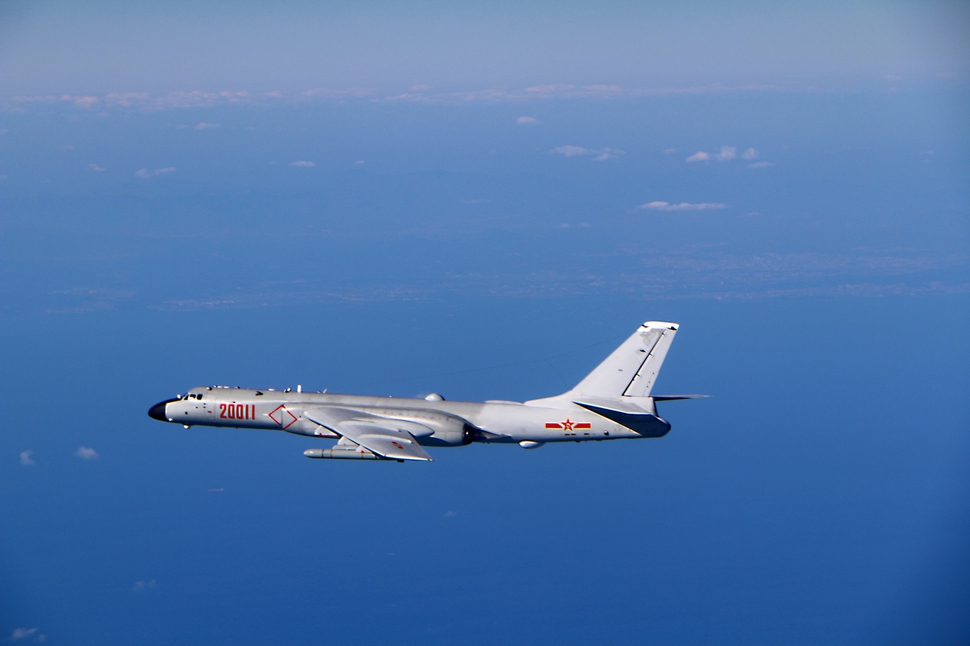 |
|
A Chinese military aircraft in Japanese air defense identification zone (ADIZ) before entering South Korean ADIZ on Dec. 19, 2017. (Hankyoreh archives)
|
7th infiltration this year likely aimed at neutralizing flight zones
On Nov. 26, a Chinese military aircraft that was presumed to be a Y-8 reconnaissance plane entered South Korea’s air defense identification zone (KADIZ) without advance notification. This is the seventh time that South Korea’s Defense Ministry has gone public about such an incident this year, following previous incidents in January, February, April, July, August and October. Reportedly, other incidents were not made public. This raises questions about why China is repeatedly sending planes into this zone without notice despite the risk of an accidental clash. An air defense identification zone (ADIZ) is a sort of buffer zone that countries set up around the perimeter of their sovereign airspace for protection. South Korea requests that the aircraft of other countries provide advance notification before entering this zone in order to prevent accidents or accidental clashes there. But China has never provided such notification before sending its aircraft into the KADIZ. China has persisted in such behavior, even though the South Korean government regards it as a potential threat and a violation of its airspace and has scrambled fighters, including F-15Ks and KF-15s, in each instance. China has told the South Korean government that its aircraft enter the KADIZ on routine maneuvers which do not pose a problem under international law. This argument is not completely false, since the ADIZ concept has a weak basis in international law. But explanations by officials in South Korea’s Ministry of Defense and Ministry of Foreign Affairs enable us to infer why China is sending aircraft into the KADIZ without notification nearly once a month despite the risk of an accidental clash. At the present, South Korea, the US and Japan recognize each other’s ADIZ, but not China’s. China likewise does not recognize these three countries’ ADIZ. China’s unauthorized entrance into South Korea and Japan’s air defense identification zones on no fewer than seven occasions this year is likely aimed at neutralizing those zones. For the most part, the Chinese aircraft that have entered and flown through the KADIZ without permission between January and November of this year have originated southwest of a submerged reef known as Ieo Island and flown across the Straits of Korea and through the corridor east of Gangneung and west of Ulleung Island. The airspace around the reef is a point where the ADIZ declared by not only South Korea but also China and Japan overlap, and China also claims jurisdiction over the reef itself, which is controlled by South Korea. China potentially trying to expand its airspace So far, the two countries have been unable to overcome their differences about whose exclusive economic zone the waters around the reef belong to. Some believe that China’s repeated unauthorized intrusions into the KADIZ are part of its strategy to turn the reef into a disputed area by exercising its authority there. Another possible reason that China sends spy planes into South Korea and Japan’s ADIZ on flights that last for an average of two hours is because it’s attempting to collect information about the combat readiness of forces around the Korean Peninsula. “China appears to be making its presence known while also carrying out drills to survey its potential sphere of activity in the event of a crisis, taking into account the US alliances with Japan and South Korea. The area around Ieo Island is particularly important strategically since it occupies a strategic corridor across the Straits of Korea to Japan,” said Kim Heung-gyu, director of Ajou University's Chinese Policy Research Institute. What solution could there be to the issue of China’s trespassing in the KADIZ? During the 5th ASEAN Defense Ministers’ Meeting-Plus on Oct. 19, South Korean Defense Minister Jeong Kyeong-doo reportedly met Chinese Defense Minister Wei Fenghe and discussed resuming working-level talks about air defense between the two countries and setting up an additional air force hotline. In effect, this was a request for China to use such a hotline to notify other countries before entering their ADIZ. But China reportedly has yet to respond eagerly to this idea. By Noh Ji-won, staff reporter Please direct comments or questions to [english@hani.co.kr]






